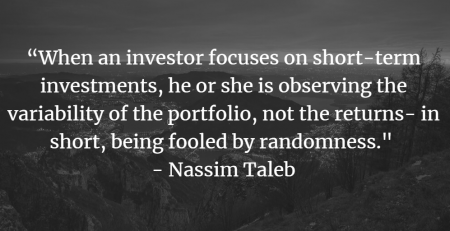Why Use Active Management, Doesn’t it Consistently Underperform?
We believe that a low-cost, passive investing strategy such as an S&P 500 index fund has a place in our industry – after all, for most retail investors who cannot invest the time, nor have the expertise, or the experience, then investing in a highly diversified ‘market’ portfolio is probably the best course of action. Said another way, it is better to own 500 stocks that you know nothing about than to own just 1 stock that you know nothing about.
The problem, however, is that much of the professional investing industry has taken that initial concept of passive investing and used it as an excuse to forgo any active investment responsibility at all – instead offering their clients ‘average’ results and then charging a fee on top for their services.
When asked why professional money managers spend so little effort on maximizing investment performance and instead are happy to use passive strategies, these managers will typically argue that the market is efficient and active management fails to beat passive investing over long periods of time.
There are hundreds of articles declaring just that, consider two recent pieces:
- In one of the most volatile markets in decades, active fund managers underperformed again: “Of the nearly 3,000 active funds Morningstar analyzed, only 47% survived and outperformed their average passive counterpart in the 12 months through June 2021.”
- Most pros can’t beat the market: “According to new data from S&P Dow Jones Indices, 60.3% of large-cap equity fund managers underperformed the S&P 500 (^GSPC) in 2020. This marks the 11th straight year that pros lagged that benchmark.”
As tends to be, these statistics are highly misleading. Not only is the narrative that they paint false, but worse yet, many in our industry know that it is false but prefer it to the alternative of having to bear any responsibility for actual investment performance. Let us explain.
Most Active Managers Aren’t Actually Active Managers
When any news article proclaims, “Active managers have…”, the first question you have to ask is how are they defining what counts as “Active”? After all, active management is a broad term that includes many strategies ranging from short-term computerized trading to long-term buy and hold, to everything in between. And the problem is that most so- called “active” strategies aren’t even active at all – in reality, they are much closer to passive index funds.
To understand how this selection bias affects things, consider that there have been numerous studies that analyze those active managers that do in fact beat the market. Most notably, consider the work of Cremers and Petajisto:
- Patient Capital Outperformance: The Investment Skill of High Active Share Managers Who Trade Infrequently
- How Active is Your Fund Manager? A New Measure That Predicts Performance
- Active Share and Mutual Fund Performance
The findings in these studies will come as little surprise for most in our industry – it turns out that the strategy that most correlates to outperformance is one that is 1) high active share and 2) low turnover.
Let’s look at each of those in turn:
- High active share just refers to how different a portfolio is from an index. So, if a portfolio only owns stocks that aren’t in the S&P 500, its active share relative to the S&P 500 would be 100%. If a portfolio is identical to the S&P 500, its active share would be 0%. Rather obviously, active managers with low active share (the closet indexers) will have a very difficult job beating the market since they are effectively invested in the market.
- Low turnover means that a manager doesn’t trade in and out of positions frequently. This is another way of saying they have conviction in what they own and the patience to ride out short-term quarterly earnings and news-flow-driven price volatility. In other words, they don’t get swept up in the futility of short-term market timing.
If you go back to those news articles above, you will find that most of the so-called ‘active’ funds in their samples have low active share and high turnover – the exact opposite of what you want. Despite it being very clear what works in our industry, most active managers do the opposite – they run very diversified, high turnover strategies. In fact, the number of high active share, low turnover strategies have been consistently falling in the market for the past four decades.
If it’s so Obvious What Works, Why Does Most of the Industry do the Opposite?
There are two main reasons for this disconnect: 1) it takes a lot of hard work to run a truly active portfolio, and 2) high active share, low turnover portfolios come with much more short-term price volatility which creates psychological issues for both managers and investors alike.
Most investment firms place far too much focus on short-term performance (often because clients want it), and place targets on fund managers to not significantly underperform an index or peer group, even over a period as short as a quarter. How do these managers avoid underperforming an index or peer group? Well, they look the same as their index or peer group, that’s how.
This leads to that closet indexing effect that we spoke about earlier. And while their portfolios may look like the index, these same fund manager still know they need to show they are doing something over and above an index to justify their fees, so they end up trading far too often, leading to high turnover. At the end of the day, replicating an index and then trading all the time is clearly not going to lead to the best outcome for investors, hence it shouldn’t come as a surprise that it hasn’t done so for many years.
And there is another high-level incentive mismatch here: investment firms are paid predominantly based on assets under management rather than on performance – the firms get a big paycheck whether they beat the market or not, so why not just play safe, achieve average, and call it a day? Have you ever wondered why the largest investment firms in the world aren’t those with the best performance?
In other words, it is not that active management doesn’t work, it is that the strategies favored by most active managers don’t work. And the simple reason for that is, for most active managers, investment performance isn’t necessary for their success. This is a great deal for these so-called active managers, but not a great deal for their investors.
Disclosures: This website is for informational purposes only and does not constitute an offer to provide advisory or other services by GCI Investors in any jurisdiction in which such offer would be unlawful under the securities laws of such jurisdiction. The information contained on this website should not be construed as financial or investment advice on any subject matter and statements contained herein are the opinions of GCI Investors and are not to be construed as guarantees, warranties or predictions of future events, portfolio allocations, portfolio results, investment returns, or other outcomes. Viewers of this website should not assume that all recommendations will be profitable, or that future investment and/or portfolio performance will be profitable or favorable. GCI Investors expressly disclaims all liability in respect to actions taken based on any or all of the information on this website.
There are links to third-party websites on the internet contained in this website. We provide these links because we believe these websites contain information that might be useful, interesting and or helpful to your professional activities. GCI Investors has no affiliation or agreement with any linked website. The fact that we provide links to these websites does not mean that we endorse the owner or operator of the respective website or any products or services offered through these sites. We cannot and do not review or endorse or approve the information in these websites, nor does GCI Investors warrant that a linked site will be free of computer viruses or other harmful code that can impact your computer or other web-access device. The linked sites are not under the control of GCI Investors, and we are not responsible for the contents of any linked site or any link contained in a linked site. By using this web site to search for or link to another site, you agree and understand that such use is at your own risk.






